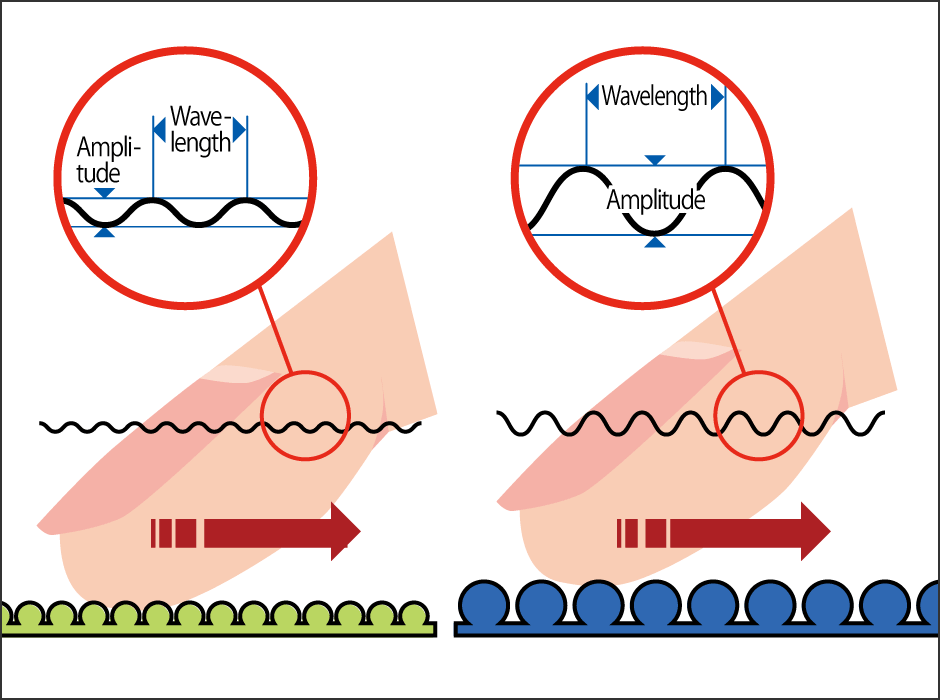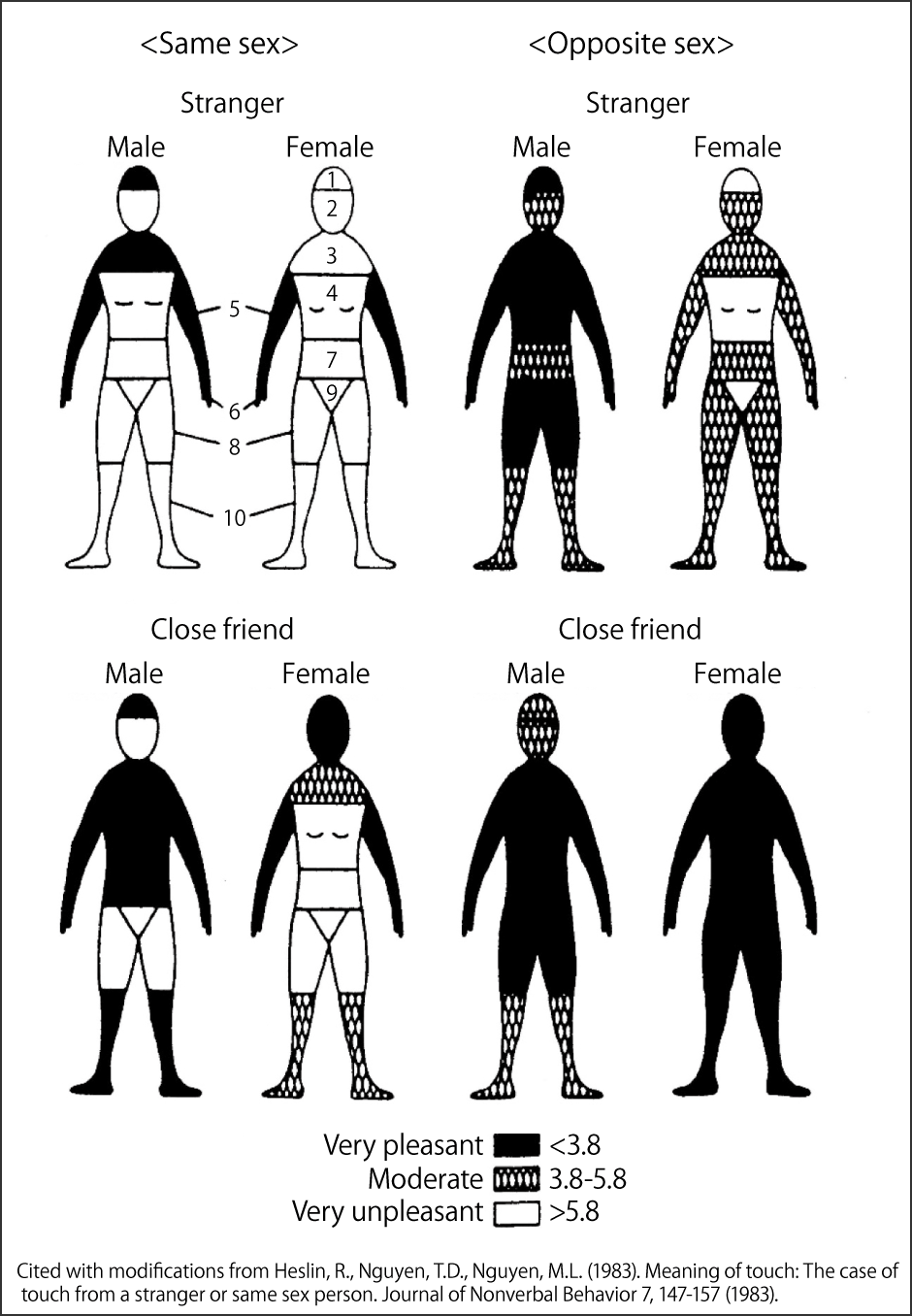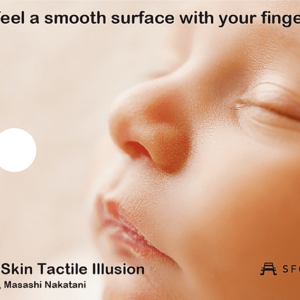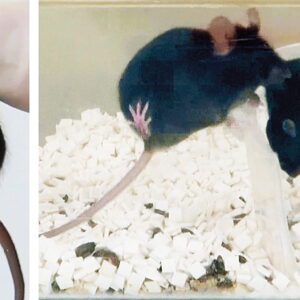Touch is the most primitive of the five senses, which organisms gained at an early stage in their evolution as a sense essential to defending themselves. It has unique features from a biological perspective, such as the ability to detect even subtle differences. Touch is an intricate sense with the power to reach deep inside us. Physically touching something or being touched can soothe or relax us, and our experience of it is also influenced by differences in sex and cultural background.
Special Feature 1 – The World of Touch The mysteries of the profoundly intricate sense of touch enabling us to detect even subtle differences
composition by Rie Iizuka
What sort of sensation comes to mind when you think about the word “touch”?
First of all, there is what you might call the sensation of pressure that comes from touching or being touched. That may refer to touch in its narrow sense. I think it is easy to imagine what it would be like if you lost your sense of taste, hearing, or smell. If you close your eyes, you can no longer see anything. Block your ears and you cannot hear anything. Pinch your nose and smells disappear.
But what if you lost your skin surface? Could you imagine what that would be like? Touch is a low-key, unobtrusive sense, as tactile mechanoreceptors are located throughout the body, making it hard to notice what and where are functioning. Some people even describe it as the silent sense.
Touch receptors located throughout the body
Touch is sometimes discussed as a sense associated with proprioception (force sensation), that is to say, the sensation of position and movement of one’s own limbs, the sensation of muscle tension and relaxation, and the intensity of resistance when pushing or grasping something. As touch and proprioception frequently function simultaneously, they are also referred to as somatic sensation.
Touch is said to be the most primitive of our five senses. As touch is shared by humans, worms, and unicellular organisms alike, it can certainly be considered so from the perspective of evolutionary theory. In vision, as life evolved into multicellular organisms, the photoreceptor cells were built up and the eyegrounds were formed, and were followed by structures like a pinhole camera that formed rudimentary eyes, through which the organisms were able to acquire a wealth of information. Similarly, the auditory system was born from clusters of cells that detect vibration in water or the air, which developed into the eardrums and the small bones called the auditory ossicles. Thus, our senses of vision, hearing, taste, and smell developed through the formation of dedicated organs suited to processing the relevant information at extremely limited sites.
However, I believe that our tactile receptors evolved in a slightly different direction. Tactile receptors are spread throughout the body, as their role is to gather information to defend the organism against intrusion from outside. It is believed that when unicellular organisms such as bacteria respond to impact by fleeing from the intruders, they use touch, rather than vision or hearing. If the body membrane breaks, allowing moisture to flow out, then viruses and bacteria can infect the organism, causing terrible problems. The barrier between the organism and the outside world —— the skin in humans —— to guard against intrusion by life-threatening external enemies is absolutely vital to keeping life safe.
Touch is a risk avoidance sensor
In fact, the ability to tactually react to external intrusion —— that is to say, to react to pressure —— is far superior to the other senses. The Weber fraction is an indicator that quantifies the sensitivity of vision, hearing, and other senses (Table). For example, in vision, it indicates the minimal light intensity that is needed to discern the difference between standard brightness and comparative brightness. The lower the figure, the keener the sense. When the Weber fraction of deep touch is compared with the fractions of vision and hearing sound, touch to deep pressure is the most sensitive. While the skin is said to be less sensitive than other sensory organs in some respects, the tactile receptors have to be acutely sensitive to deep pressure because it serves as the body’s defensive wall, enabling it to perceive external stimuli and the risks thereof.
| Standard Stimulus | Weber Fraction | |
| Deep pressure | 400 g | 1/77 |
| Visual brightness | 1,000 trolands | 1/62 |
| Lifting a weight | 300 g | 1/53 |
| Loudness of sound | 1,000 Hz, 100 dB | 1/11 |
| Smell(smell of rubber) | 200 olfacties | 1/10 |
| Pressure on skin | 5 g/mm2 | 1/7 |
| Taste(salty taste) | 3 mol/L | 1/5 |
Table. Weber fractionsWeber fraction indicates the minimal increase (or decrease) that is required for people to discern a difference between the standard stimulus and the comparative stimulus. This fraction makes it possible to estimate, for example, what percentage increase (or decrease) in light intensity from 1,000 trolands is required for it to seem brighter (or darker). In the case of deep pressure, when the standard stimulus is 400 g, a person will feel a change for an increase of approximately 400 × 1/77 (i.e., 5.19 g) in weight. Since the fraction for brightness is 1/62, one can say that touch is more sensitive than vision.
Another aspect to which the skin is sensitive is roughness and smoothness. Even if you cannot tell what a fabric is just by looking at it, you can distinguish silk from cotton once you touch it. The perception of such fine textures is said to be achieved by vibration.
Organisms are very sensitive to vibration and the sensation generated by touching fabric is actually due to vibration (Figure 1). The word “vibration” might make us think of the ground shaking, but in fact, when you rub a piece of fabric with your finger, the fine texture of the fabric transmits vibration to your fingertip.

Figure 1. Touching a fabric surface with a fingertipWhat is felt by the fingertip is the vibration caused by the pattern of particles on the fabric surface. If the particles have a larger diameter, the wavelength between them lengthens and the amplitude increases.
It is often the case that you can tell what something is when you touch it, even if you cannot just by looking at it. Most ordinary people will notice differences in particle diameter between a few micrometers and ten micrometers if they rub a piece of sandpaper with a fingertip. That is how acutely sensitive our sense of touch is.
So what kind of sensations do we get from touching something? The information transmitted differs according to the way in which we touch something —— that is to say, whether we touch it with a fingertip or both hands, or whether we exert pressure by gripping or bending it. In addition to the basic tactile dimensions, namely hard/soft, rough/smooth, slippery/sticky, and warm/cold, we feel weight, thickness, and brittleness by grasping, gripping, and bending items.
Research has been undertaken since the latter half of the 19th century to answer the question of how the information sent to us from outside is processed and in what part of the skin, in order to end up as a tactile dimension. Other sensory organs have specialized receptors: the retina in the eye, the cochlea in the ear, and the taste buds in the tongue. In that case, it is also likely that there should be specialized receptors associated with the sense of touch.
That hypothesis led to the discovery of a number of subcutaneous receptors (Figure 2). The receptors for pressure, temperature, and pain distribute across the epidermis, dermis, and subcutaneous tissue. Some have specialized structures, while others —— called free nerve endings —— do not have specialized structures and are just nerve fibers that branch off at the tip. The receptors shown in Figure 2 each respond differently to the frequency, strength, duration, and area of the stimulus. By such receptors, we feel a variety of cutaneous sensations.

| Properties of mechanoreceptors | |||||
| Mechanoreceptive Unit | Diameter of Receptive Field | Boundary of Receptive Field | Effective Stimulus | Terminal Receptor | Sensation |
| Rapidly adapting I | A few mm | Distinct | Speed of stimulus | Meissner’s corpuscle | Low-frequency vibration |
| Rapidly adapting II | 1 cm to a few cm | Indistinct | Acceleration of stimulus | Pacinian corpuscle | High-frequency vibration |
| Slowly adapting I | A few mm | Distinct | Movement and speed of stimulus | Merkel cell | Pressure |
| Slowly adapting II | 1 cm to a few cm | Indistinct | Movement of stimulus | Ruffini ending | Unconfirmed |
Figure 2. Tactile receptors and the properties of mechanoreceptorsThere is still debate concerning touch receptors. The theory that Pacinian corpuscles are the receptors that detect vibration is well established, but receptors and sensation do not necessarily have strict one-to-one correspondence. For example, temperature sensation occurs even in parts that do not have the receptors believed to feel warmth, such as Ruffini endings and Krause’s corpuscles. On the other hand, four types of mechanoreceptive units are thought to be related to the senses of touch, which can be classified according to the adaptive velocity of the receptive field (the area of skin that affects the activity of a single sensory nerve) and the size of the receptive field: rapidly adapting I, rapidly adapting II, slowly adapting I, and slowly adapting II. Receptive units can be broadly classified into large and small units and are further divided into those in which, when stimulus is applied to the skin, the nerve reacts quickly, but then stops reacting after a while, and those in which the nerve reacts over the whole time the stimulus is applied.
The mechanism whereby our hands become our eyes
We can find a wallet in a bag just by exploring with the fingers. This is possible due to not only the sense of touch, but also the proprioceptive sensors for our body’s defensive wall, which enable us to perceive external stimuli and the risks thereof.
First, by moving our fingertips, we can detect the weight and thickness of an object via proprioception. The four types of mechanoreceptive units shown in Figure 2 detect hardness and roughness and our memories of the wallet’s shape are superimposed on our sense of touch, thereby enabling our hands to become our eyes.
While proprioception is often omitted from the framework of research on touch, when we actually touch an object, we do not just rub it with our fingertips, but also pick it up or grip it. In that situation, our muscle movements provide information, which is why people with well-developed muscles feel things in a different way from elderly people. As in vision and hearing, one also finds individual differences in touch —— including those due to aging ——. In particular, it has become clear that the ability to feel vibration declines with age.
I first study vision and subsequently expanded the field of research to include touch. Even before that, people had talked about vision and touch being closely linked. It is said that humans obtain about 80% of their information from vision and, as the volume of information is so huge, interest has tended to focus on vision. However, from the Middle ages until about the beginning of the 20th century, many researchers espoused the theory of haptic capture, which held that “touch teaches vision.” This way of thinking seems to have been replaced in the mid-20th century by visual capture, but, as described above, touch is a basic sense that has some highly sensitive aspects and sight is believed to be influenced by it to no small degree.
So far, we have looked at touch from a biological perspective, but there are also individual differences in terms of the social perspective of touch —— that is to say, their tactile sensitivity in their relationships with others. One psychology study examined the parts of the body on which people tolerate being touched. It asked respondents about the parts of the body on which they would not mind being touched by a close friend of the same or opposite sex and by a total stranger of the same or opposite sex (Figure 3). The results showed that women have a strong disinclination to being touched anywhere between the chest and the hips by an unfamiliar man or a person of the same sex, but are happy to be touched anywhere by a man to whom they have a close relationship.

Figure 3. Meaning of touch by sex and level of intimacyThe legend indicates how pleasant or unpleasant the respondent felt for touch, with 5.8 or above for very unpleasant and 3.8 or below for very pleasant. Top left: Reactions of men and women when touched by a stranger of the same sex. Bottom left: Reactions of men and women when touched by a close friend of the same sex. Top right: Reactions of men and women when touched by a stranger of the opposite sex. Bottom right: Reactions of men and women when touched by a close friend of the opposite sex. Even where the level of intimacy is the same, the body parts where the respondent felt pleasant by being touched differ between men and women. In women, the range of contact tolerated expands as intimacy increases.
Women are highly sensitive to touching and being touched by strangers. Women try to avoid being in close contact with the person next to them on trains, whereas men do not mind and often do not even notice when they are touching someone. Such sex-based differences are thought to be strongly related to the question of reproduction. As humans are animals, women obviously seek to defend themselves in regard to reproduction. They protect themselves to keep away from danger.
At the same time, it is commonly accepted in the field of psychology that women are highly social and eager to form close relationships and communicate with others. As a result, they tend to maintain closer interpersonal distances and touch others. Once particularly familiar with someone, they tend to proactively touch them. Men, on the other hand, have a tendency to want to be alone and to avoid contact with others. Thus, men are deemed to be individual, while women are regarded as social.
Japanese people are not opposed to social distancing
The social aspects of touch are also strongly influenced by cultural factors. It would seem fair to say that Japanese people have a higher resistance to touching others than those from cultures where people hug and kiss each other by way of greeting. Since they were told that they should avoid contact with others due to the COVID-19 crisis, most Japanese people do not seem opposed to social distancing and wearing masks. I believe that this is because the foundations for accepting this state of affairs had already been laid in Japan.
In Japanese homes, each member of the family has their own rice bowl, chopsticks, teacup, and other items of tableware that are theirs and theirs alone, and I believe that they would feel rather uncomfortable about someone else using their own eating utensils. However, in the West, the concept of having one’s own personal knife and fork does not exist at all.
The study I mentioned above about people’s tolerance for being touched by others was carried out overseas. Given our behavioral customs and cultural background, I believe that the results would probably be very different if a similar study were conducted among Japanese people.
The act of touching increases people’s feelings of security and affection. Touching and being touched is quite soothing when one is upset. Patients with psychiatric disorders can make quite a good recovery just by holding hands with someone else (so one could say that becoming able to touch someone else is a sign of improvement). No words are necessary —— it is enough just to have another living creature beside them. I have heard of cases where improvements have been seen in people with dementia just from stroking a service dog, even though it cannot talk. Stroking the head of a robot designed to look like a pet has a similar effect. I believe that understanding touch will enable us to gain a deeper understanding of humans and other creatures.




















